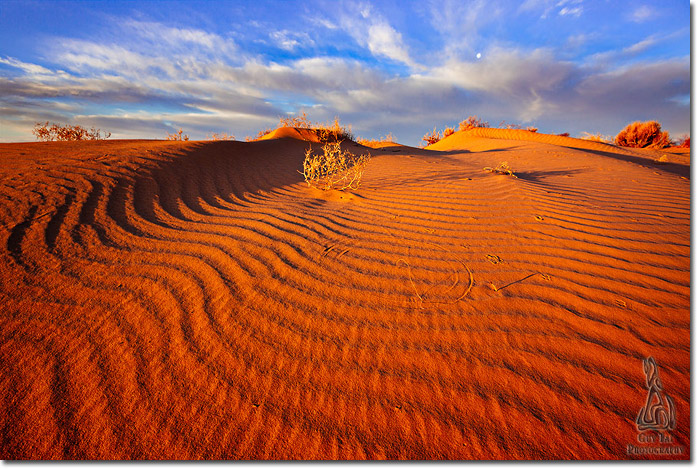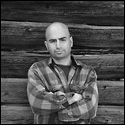The Absence of Humans |
In his critique of a recent National Park photography exhibit, Boston Globe Pulitzer Prize-winning critic Mark Feeney decries the absence of human presence in the works presented, suggesting that such deliberate oversight renders the photographer's interpretation "highly limited, and effectively superficial."
Such critique is often leveled at photography of natural subjects for obvious reasons. In most places on Earth today, it is all but impossible to escape the presence and effects of human activity. The vast majority of humans may spend an entire lifetime never knowing a silence completely devoid of the incessant cacophony of machines and media; never gazing upon a scene that still looks as it did thousands of years before their time; never venturing outside the range of radio signals and cellular phone coverage; never having to rely on their own faculties to find their way and to ensure their safety. Moreover, most will likely not expect such experiences to even still exist, let alone be found in the midst of a rich, modern and industrialized nation like the United States. And yet, they are still available on the Colorado Plateau.
The age of the Colorado Plateau is still a matter of scientific debate, with the most recent theory placing it at about seventy million years. By comparison, the first humans in the region are estimated to have arrived between ten and fifteen thousand years ago. Western explorers had only discovered the region a few hundred years ago, and the arbitrary constructs of government, states, cities, towns, parks, monuments and wilderness areas still more recent than that. In terms of time alone, it is actually the reign of humans that is but a limited and superficial veneer over a place already rich in history and complexity since long before Homo Sapiens ever set foot on Earth.
Though in many places the impact of human activity is profound and undeniable, the grand story of the Plateau is, by and large, not about the antics of humans. In fact, attempting to constrain the character of the Plateau to just its human history is akin to trying to determine all that makes up a dog through the stories of ticks, and if the ticks had only just arrived a couple of minutes ago.
Portions of the Plateau were the last places in the contiguous United States to be mapped. Vast tracts of it remain uninhabited by humans, and it is not unlikely that some of its more remote regions have never been visited by a human at any time.
Indeed, one of the most distinguishing and defining characteristics of life on the plateau is the scarcity of humans. It is a place where sensory and cognitive stimulus can still be isolated from the din of our hives, distilled to singular uninterrupted and unimpeded threads, free of distraction and capable of penetrating into emotional and spiritual depths not possible in so many human-made settings.

The lives of humans, while rich in drama and important lessons, are not all that there is. Existence, in any meaningful sense, is far greater than one species well on its way to setting a record for least amount of time spent as a top life form on a small planet in an unremarkable solar system on the outskirts of an unexceptional galaxy in a universe of trillions of other worlds. While such admissions do not pertain solely to the landscape of the Colorado Plateau, they do imply that, as humans, we have the capacity to value knowledge, to transcend instinct and to derive value from things outside of ourselves; things that do not necessarily culminate in material reward; things that we may not have a direct way of measuring, quantifying, pricing or otherwise relating to in tangible, utilitarian terms.
It is in those realms beyond the enterprises of humanity that the greatest rewards and the greatest misperceptions of places like the Colorado Plateau are manifested. To those who can recognize the value of thought for the sake of thought, discovery for the sake of discovery, emotion for the sake of emotion, understanding for the sake of understanding and spirituality for the sake of spirituality, the Plateau in its pristine form is rich in meaning, mystery and knowledge that cannot be accomplished by artificial means nor directly attributed to the presence of human beings.
Those who fail to place proper value on the abstract; on the recognition that there is more to know, more to learn, more to question, more to experience, and more to be rewarded by than the incessant preoccupation with ourselves, our needs and our contrived rituals will similarly fail to appreciate and, ultimately, fail to preserve and protect anything that can otherwise be substituted for material gain.
I am of the school of artists who believe that art should augment and enrich life, rather than merely document and mimic it under arbitrary constraints of time, place, content or the fleeting fashions, sensibilities and beliefs of the time. Art should enlighten, reveal, pose questions and suggest possibilities, explore and ponder and expand perceptions, challenge and tantalize, and vigilantly force audiences to examine and appreciate those things beyond the mere trivial makings of everyday life. Not doing so is akin to denying the very things that make us human: the ability to think, rationalize, abstract and relate; the ability to tackle complexity and infer meaning, the desire to understand and the ability to appreciate beauty.
What little of the Plateau's human history you will find here is mostly in remnants of cultures long gone, leaving in their wake as much of the mysterious and the spiritual as the land itself. Though relatively little is known of their lives, it is widely assumed that theirs was a society more inclined to seek harmony with the land and more attuned to the spiritual and the emotional. It is not unlikely that their ultimate demise was brought about by those in their midst who did choose to place possession and dominion over the quest for knowledge and a peaceful existence, and who limited their perception of meaning and reward to the glorification of themselves. May we wisen up in time to avoid their fate. May we learn to find joy in things simply being what they are, for their own purpose, in their own right and independent of our presence.
Comments on NPN nature photography articles? Send them to the editor. NPN members may also log in and leave their comments below.
 Guy Tal is a professional photographer and author residing in the state of Utah, in the heart of a unique and scenic desert region known as the Colorado Plateau. Guy teaches and writes about the artistic and creative aspects of photography and guides private workshops and individuals seeking the beauty and solitude of the canyon country. More of his works and writings can be found on his web site and blog at guytal.com. You may also follow Guy on Facebook or Twitter.
Guy Tal is a professional photographer and author residing in the state of Utah, in the heart of a unique and scenic desert region known as the Colorado Plateau. Guy teaches and writes about the artistic and creative aspects of photography and guides private workshops and individuals seeking the beauty and solitude of the canyon country. More of his works and writings can be found on his web site and blog at guytal.com. You may also follow Guy on Facebook or Twitter.